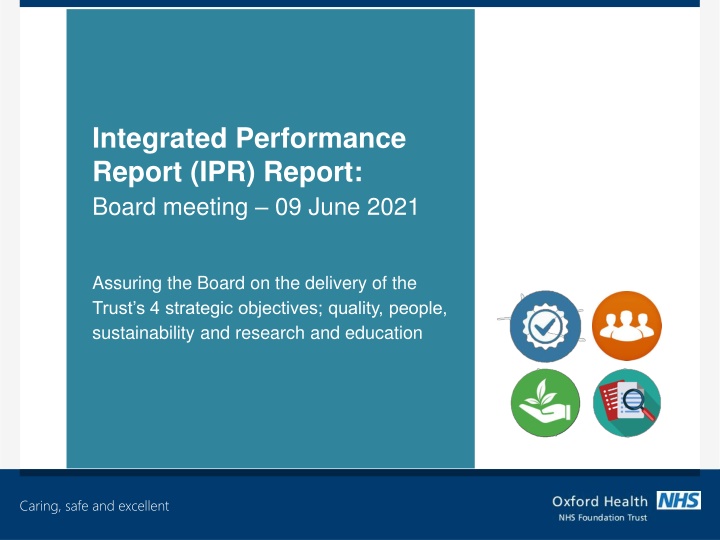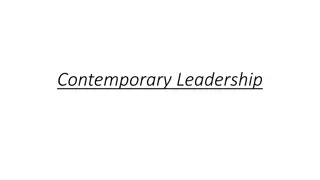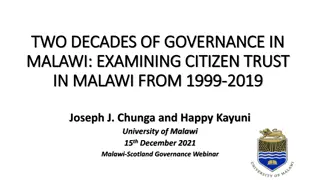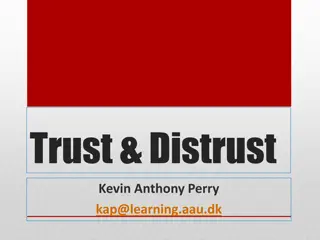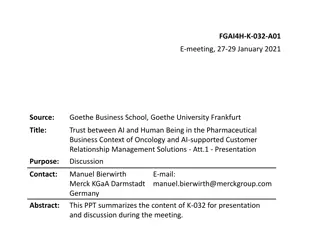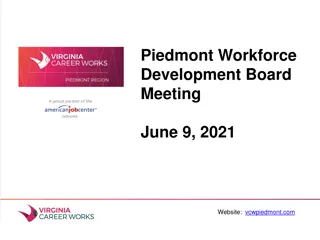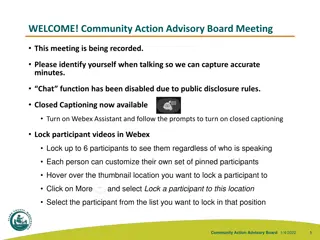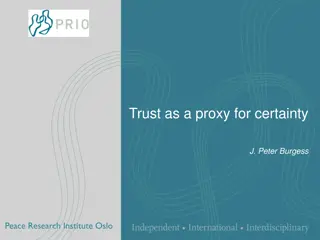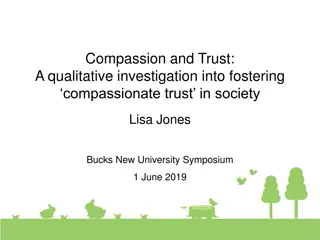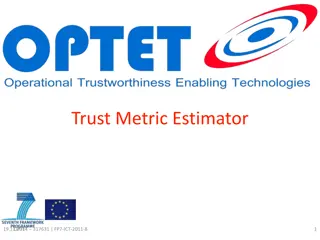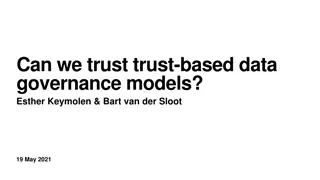Assuring Trust's Strategic Objectives Delivery in Board Meeting
The Integrated Performance Report presented at the board meeting on 09 June 2021 assures the Board on the delivery of the Trust's strategic objectives - quality, people, sustainability, and research & education. The report highlights key focus areas, workstreams, and metrics to track progress towards the Trust's vision of outstanding care complemented by values of being caring, safe, and excellent.
Download Presentation

Please find below an Image/Link to download the presentation.
The content on the website is provided AS IS for your information and personal use only. It may not be sold, licensed, or shared on other websites without obtaining consent from the author.If you encounter any issues during the download, it is possible that the publisher has removed the file from their server.
You are allowed to download the files provided on this website for personal or commercial use, subject to the condition that they are used lawfully. All files are the property of their respective owners.
The content on the website is provided AS IS for your information and personal use only. It may not be sold, licensed, or shared on other websites without obtaining consent from the author.
E N D
Presentation Transcript
Integrated Performance Report (IPR) Report: Board meeting 09 June 2021 Assuring the Board on the delivery of the Trust s 4 strategic objectives; quality, people, sustainability and research and education Caring, safe and excellent
Section 1: Introduction to the Trust strategy 2021-2026 Caring, safe and excellent
Introduction to the Trust Strategy 2021-2026 Executive Summary: Martyn Ward, Director of Strategy and CIO Introduction to the Trust Strategy 2021-26 Oxford Health NHS Foundation Trust (OHFT, the Trust) has developed an organisational strategy for the five year period 2021-26. The aim of the strategy is to set the Trust s long-term direction, guide decision-making and address strategic challenges for example rising demand for and complexity of healthcare, recruiting and retaining a stable workforce, and ensuring sufficient resourcing. Following the publication of the 2021 NHS White Paper, the NHS is likely to change over the period of the strategy - shifting from a commissioner/provider model to one characterised more by system working and collaboration with healthcare partners (NHS, local authority, independent and third sector) focused on collectively improving overall population health and addressing health inequalities. The Trust s vision is Outstanding care by an outstanding team, complemented by the values of being Caring, Safe & Excellent. Flowing from the vision and values are four strategic objectives: 1. 2. 3. 4. Deliver the best possible care and outcomes (Quality) Be a great place to work (People) Make the best use of our resources and protect the environment (Sustainability) Become a leader in healthcare research and education (Research & Education) Key focus areas and Objective Key Results To move the strategy into a focus on delivery, each strategic objective has been developed into a set of key focus areas (workstream descriptors). The aim of the key focus areas is to identify priority activities and workstreams for the Trust over the coming years and to provide a bridge between the high-level ambitions of the strategic objectives and a set measures and metrics to track progress. Existing and new measures and metrics have been gathered and/or created using an Objective Key Results (OKRs) approach. OKRs allow for measurement of activities that contribute to key areas of focus and workstreams and will be reported to relevant Board committees and Board via an Integrated Performance Reporting approach. While the key focus areas are intended to be fixed for the lifespan of this strategy, the OKRs can be updated and added to as required. To enable this, the OKRs are an appendix to the main Trust strategy document. This approach allows for a consistency of approach for the strategy but the flexibility to adapt the metrics used to measure progress. For example, a specific OKR may be achieved and can then be replaced with a new target. This report reports delivery of the strategy and performance against the OKRs. Supporting data and narrative is supplied where there is underperformance. Caring, safe and excellent
Section 2: Trust Headlines April 2021 Caring, safe and excellent
* Referrals, Patients, Seen and Admissions excludes: Specialist Mental Health Services, OOH/MIU and Out of Area Placements Patients seen Referrals Admissions Activity Admission & LOS Attended contacts delivered No. distinct patients seen Referrals Received 5860 referrals to Adult Mental Health Services (incl. IAPT). +9.4% increase on the 2019/20 monthly average of 5355 96 admissions to Adult/Older Adult Mental Health wards (inc rehab).5.9% fewer than the 2019/20 monthly average 30,377 attended contacts in Adult Mental Health Services (inc IAPT). +45% higher than the 2019/20 monthly average of 20,892 14,217 Adult Mental Health (incl IAPT) distinct patients seen. +28.2% more than the 2019/20 monthly average of 11,088 125 admissions to Community Hospital wards. +10.6% more than the 19/20 monthly average 2446 referrals to Child & Adolescent Mental Health Services. +4% increase on the 2019/20 monthly average of 2349 12,972 attended contacts in Child & Adolescent Mental HealthServices. +15.2 higher than the 2019/20 monthly average of 11,003 5,383 CYP Mental Health distinct patients seen. +8.1% more than the 2019/20 monthly average of 4945 63 ALOS on Adult/Older Adult Mental Health wards (inc Rehab, exc leave/delay). +10.5% longer than the 19/20 average 10947 referrals to Primary and Community Care Services (excl. OOH/MIU). Which is broadly in line with the 2019/20 monthly average of 10,966 54940 attended contacts in Primary and Community Care Services (exc OOH/MIU). -6/6% lower than the 2019/20 monthly average of 58,580 31,004 Primary and Community patients seen. -9.0% fewer than the 2019/20 monthly average of 33781 21 ALOS on Community Hospital wards (exc delay). -16% shorter than 19/20 average Caring, safe and excellent
Quality Finance L&D Workforce SIs, Complaints & Compliments New starters, Leavers & HR mgmt. cases resolved Appraisals, Supervision & Training Finance 5 Serious Incidents occurred. +67% (2) more than the 2019/20 monthly average of 3 488k spent on Out of Area Placements.+110% higher than the 2019/20 monthly average of 232k 185 new starters in month. +20% higher than the 2019/20 monthly average of 154 244 appraisals completed in April 2021. 94% more than April 2020 at 126 completed 14Complaintsreceived in April. +33% (7) fewer than the 2019/20 monthly average of 21 3274 Supervision sessions carried out in April 2021 +8% from April 2020 of 2314 191 leavers in month. +41% higher than the 2019/20 monthly average of 135 4180k spent on Agency Staff.+106% higher than the 2019/20 monthly average of 2034k 93.5% positive overall patient experience(average score 4.76 out of 5) (responses=784). 94% positive overall score 2019/20 (average score 4.77 out of 5) (responses=20,926) 3454 Training courses attended (digital and classroom). + 59% compared to April 2020 of 2023 training courses 15 HR management cases resolved in month. -37% fewer than the 2019/20 monthly average of 23.8 113k spent on travel claims. -53% lower than the 2019/20 monthly average spend of 238k Caring, safe and excellent
Section 3: Delivery of the NHS Oversight Framework Caring, safe and excellent
National objective: Compliance with the NHS Oversight Framework This year, the NHS Oversight Framework indicators that have targets are; Target National position Latest Trust Position (N1) A&E maximum waiting time of four hours from arrival to admission/transfer/ discharge 95% 85.4% 95.5% (Apr) (N2) People with a first episode of psychosis begin treatment with a NICE-recommended care package within two weeks of referral (UNIFY2, moving to Mental Health Services Data Set MHSDS) (quarterly) 56% 67.8% (Dec) 78.6% (Mar) (N3) Data Quality Maturity Index (DQMI) MHSDS dataset score - reported quarterly 95% 68.5% 98.1% (Dec) (N4) IAPT - Percentage of people completing a course of IAPT treatment moving to recovery (quarterly) 50% 47.2% 57% (Dec) (N5) IAPT - Percentage of people waiting six weeks or less from referral to entering a course of talking treatment under Improving Access to Psychological Therapies (IAPT) 75% 92.6% 98.5% (Feb) (N6) IAPT - 18 weeks or less from referral to entering a course of talking treatment under IAPT 95% 98.6% 99.8% (Feb) (N7a) Inappropriate out-of-area placements (OAPs) for adult mental health services - OAP bed days used (Bucks) 0 - 5 (Apr) (N7b) Inappropriate out-of-area placements (OAPs) for adult mental health services OAP bed days used (Oxon) 0 - 27 (Apr) Governance: Executive Director: Director of Strategy and CIO | Responsible Committee: Quality Committee | Responsible reporter: Claire Page Executive Summary: Martyn Ward, Director of Strategy and CIO About: The NHS Oversight Framework replaced the provider Single Oversight Framework and the clinical commissioning group (CCG) Improvement and Assessment Framework (IAF) in 2019/20 and informs assessment of providers. It is intended as a focal point for joint work, support and dialogue between NHS England and NHS Improvement, CCGs, providers and sustainability and transformation partnerships, and integrated care systems. The table above shows the Trust s performance against the targeted indicators in the framework. Areas of non-compliance are explained overleaf. Performance: Overall performance is good with all indicators consistently achieved over the past 12 months, with the exception of the number of inappropriate out of area placements in both Oxfordshire and Buckinghamshire. Please see overleaf for more information on the cause of underperformance and the plans to mitigate the issue. Caring, safe and excellent
National Objective: areas of underperformance Objective Key Result (OKR) Target Actual Objective Key Result (OKR) Target Actual (N7a) Inappropriate out-of-area placements (OAPs) for adult mental health services aim to reduce OAP bed days used (Bucks) (N7b) Inappropriate out-of-area placements (OAPs) for adult mental health services aim to reduce OAP bed days used (Oxon) 0 5 0 27 Executive Director commentary: Martyn Ward, Director of Strategy and CIO The issue and cause Trust did not achieve the OAPs target. This was due to the ongoing changes in bed capacity as a result of Infection Prevention Control (IPC) guidance. The Trust has been operating throughout the year with up to 15% less capacity in the Adult and Older Adult Mental Health wards. The interim closure of beds has resulted in additional Out of Area placements which the Trust has mitigated by purchasing a block contract of 10 beds, which incrementally increased to 18 beds by April 2021 with a private provider Elysium Healthcare. The plan or mitigation Following recent NHSE/I guidance the Trust has reviewed the use of OAPs and is assured that continuity of care principles are adhered to. Reporting from April 2021 will reflect this change, note this change when viewing performance against historical trend. April 2021 locally reported usage was 5 Bucks, and 27 Oxon. In April, changes to IPC guidance have allowed the facilitation of patients who have completed their 14-day period of isolation and are COVID negative to be repatriated to vacant Oxford Health beds. Therefore, maximising bed capacity and reducing the need to purchase further inappropriate OAP. Caring, safe and excellent
Section 4: Delivery of our four strategic objectives Caring, safe and excellent
Objective 1: Quality - Deliver the best possible care and outcomes Governance Executive Director: Chief Nurse | Responsible Committee: Quality Committee This year, our Objective Key Results (OKRs) are; Target Comm Services Oxon & BSW Bucks Specialised Corporate & Trading Trust (1a) Clinical supervision completion rate 85% 64% 53% 65% 73% - 63.8% (1b) Number of staff trained in restorative just culture in yr 1 20 - - - - - 8 (1c) 100% achievement of the Race Equality Framework actions detailed in that plan for year one quarterly 100% - - - - - n/a (1d) Cases of preventable hospital acquired infections (YTD) <3 - - - - - 0 (1e) Reduction in use of prone restraint by 25% in year 1 <240 over 12mths - - 2 4 8 14 (1f) Patient safety partners employed to be part of the governance structure quarterly 2 - - - - - n/a (1fa) Improved completion of the Lester Tool for people with enduring serious mental illness (EIP teams) 90% - - 62% 39% - 52.8% (1fb) Improved completion of the Lester Tool for people with enduring serious mental illness (Community teams) 75% - - 33% 53% - 41.4% (1g) Evidence patients have been involved in creating their care plan (bi-monthly audit) 95% - - 68% (13/19) 89% 92% 87% (1h) 30% of clinical staff in non-learning disability services have completed internal eLearning on autism 30% 0% 0% 0% 0% 0% 0% (1i) CPA review completed within last 12 months 95% Indicator in development with data from CareNotes (1j) CPA risk assessment completed within last 12 months 95% Indicator in development with data from CareNotes Caring, safe and excellent
Objective 1: Quality - Deliver the best possible care and outcomes Governance Executive Director: Chief Nurse | Responsible Committee: Quality Committee Executive Summary: Marie Crofts, Chief Nurse The Quality OKRs are a sub-list of the quality objectives which form the annual Quality Account. The objectives were identified following a review of our risks, themes from quality information, recovery work and feedback from stakeholders. A number of the key objectives are underperforming at this point in time. Please see overleaf for more information by measure on the cause of the underperformance and the plans to mitigate the issue. We are developing reporting from CareNotes to monitor the completeness of risk assessments and timeliness of CPA reviews, which will be included in future reports. The quarterly community mental health Care Programme Approach (CPA) clinical audit also looks at the quality of documentation for these measures which we will also use to assess and improve performance. The Trust has started the following Quality Improvement Projects to address the relevant OKRs in the Quality section; Positive and Safe reduction in restrictive practice Improving the Physical Health monitoring of patients with SMI Risk Assessment formulation and documentation Working with families and carers Measuring success of race equality framework for change Caring, safe and excellent
Objective 1: Quality; areas of underperformance Objective Key Result (OKR) Target Actual Objective Key Result (OKR) Target Actual (1h) Develop and launch a new e-learning course for all staff on an introduction to autism (1a) Clinical supervision completion rate 85% 63.8% 30% 0% Executive Director commentary: Marie Crofts, Chief Nurse Executive Director commentary: Marie Crofts, Chief Nurse The risk or issue Lack of awareness and reasonable adjustments being made for patients impacting on how they access and benefit from services. The risk or issue The completion and recording of clinical supervision is below target. The clinical directorates are reporting clinical supervision between 53%-73%. The risk is staff may be struggling in their role and feel unsupported to manage difficult situations. The cause 2020/21 delay in developing and rolling out new internal training developed in partnership with Autism Oxford. The cause This is two-fold, supervision levels are likely to be higher than reported due to incomplete recording on OTR combined with operational pressures due to responding and recovering from COVID-19. What is the plan or mitigation? Tier 1 training on autism awareness has been developed and the plan is this will be mandatory for all patient facing staff. Due to launch in May 2021. The Trust has also developed an autism Master s module launching in Sept 2021. The Trust is part of the national pilots for tier 1 (patient facing but not direct care givers) and tier 2 (for direct care givers) autism training which will become mandated in 2022 we have identified staff across the Trust to complete the training. What is the plan or mitigation? A permanent Trust Supervision Lead is being recruited in May 2021 to lead on embedding quality supervision and to improve recording. A new OTR system is also due to be implemented shortly. Caring, safe and excellent
Objective 1: Quality areas of underperformance Actual Target Executive Director commentary: Marie Crofts, Chief Nurse Objective Key Result (OKR) (1fa) Improved completion of the Lester Tool for people with enduring serious mental illness (EIP teams) Context The indicator is based on the completion of the comprehensive Lester physical health assessment tool covering smoking status, lifestyle, BMI, blood pressure, glucose and cholesterol, and the associated interventions. When looking at whether a basic physical health assessment is complete the performance is higher. 90% 50.5% The risk or issue Patients may not be receiving annual physical health checks in line with evidence-based practice. The checks will help to reduce mortality for people with mental illness. The cause The underperformance is due to a number of factors including leadership, staff capacity, equipment and a reduction in face-to-face work in 2020/21 due to COVID-19. Actual Target Objective Key Result (OKR) (1fb) Improved completion of the Lester Tool for people with enduring serious mental illness (Community teams for patients on CPA) The plan or mitigation A recovery plan is in place being implemented by a task and finish group which reports monthly to the Quality and Clinical Governance Sub- Committee. Recent reports have also been presented on the work to the Quality Committee and Trust Board. 75% 43% Key actions being taken are around recruiting new physical health leads, embedding consistency across the physical health clinics and ensuring teams have the appropriate monitoring equipment. There is also work underway to improve the access to data so that teams can monitor their performance more easily. The actions so far have led to an improving trend from October 2020 across both the EIP and Community Teams. Caring, safe and excellent
Objective 1: Quality; areas of underperformance Objective Key Result (OKR) Target Actual Executive Director commentary: Marie Crofts, Chief Nurse Context The information reported is from the clinical audit for the children, adult and older adult mental health wards, including forensic. Sample size n=125 patient records. The results are only for inpatients. (1g) Evidence patients have been involved in creating their care plan (bi-monthly clinical audit) 95% 87% The OKR will be based on the clinical audits completed in the reporting month, so the scope of services included will vary. The clinical audits for the community hospital wards and on end of life care were paused during COVID-19 and are due to re-start in May 2021. The Q1 community mental health Care Programme Approach (CPA) audit should be ready to report in the next report. The CPA results in Q3 showed 86% of records demonstrated patient involved in creating their care plan, n=304. The risk or issue Patients are not always being involved in their plan of care impacting on their experience and outcomes. The cause The reason is being explored further as it is unclear if this underperformance relates to practice by staff or how/ where involvement is documented. When comparing the clinical audit to feedback received from patients through IWGC, in April 2021 675 patients Trust-wide responded to this question and overall rated their involvement in care as 4.78 out of 5.0. The plan or mitigation To understand better the reasons for the clinical audit results. A QI programme has been started to improve patient and family involvement in their care. Caring, safe and excellent
Objective 2: People be a great place to work This year, our Objective Key Results (OKRs) are; Target Community Services Oxon & BSW MH Bucks MH Specialis ed Corporate & Trading Trust (2a) Staff engagement index score (annual) to increase by 1% each year (to 74% by 2022) >/=73% 73.1% 73.0% 68.9% 70.0% 73.2% 73.0% (2b) Reduce agency usage to NHSE/I target TBC 803,667 1,160,362 633,099 359,511 89,826 3,046,464 (2c) Reducing staff sickness to 3.5% over 2021/22 </=3.5% 4.7% 3.5% 3.6% 4.7% 3.5% 4.08% (2d) EDI OKR under review TBC (2e) Reduction in % labour turnover </=10% 11.4% 12.4% 11.0% 9.2% 13.4% 11.7% (2f) Reduction in % vacancies </=9% 8.1% 13.1% 13.1% 16.3% 7.2% 10.9% (2g) PDR compliance >=90% 83% 74% 75% 86% 47% 71% (2h) PPST compliance >=90% 86% 80% 83% 88% 74% 83% (2i) Number of Apprentices as % substantive employees >=2.3% 21.54% 3.99% Governance Executive Director: Chief People Officer | Responsible Committee: People, Leadership and Culture Committee Executive Summary: Mark Warner, Interim HR Director Vacancy rates remain the key risk for the Trust and resulted in continued high use of agency staff to maintain safe staffing levels. Good progress has been made in relation to international nurse recruitment and further recruitment campaigns commenced to focus specific business units. The Programme Board is scheduled to re-start following Covid focus. Turnover for new starters remains a particular concern and reasons for this are being assessed. Sickness levels remain above target and the national benchmark, although the First Care initiative will not have showed benefits in these metrics yet as they represent a rolling 12 month period. PDR compliance remains a concern at 71% and further action will take place to promote and re-launch appraisals and development discussions. This will also be one of the 3 key focus areas in relation to the 2020 Staff Survey. Caring, safe and excellent
Objective 2: People; areas of underperformance Objective Key Result (OKR) Target Actual Objective Key Result (OKR) Target Actual </=3.5% (2c) Reducing staff sickness to 3.5% 4.08% (2b) Reduce agency usage to NHSE/I target TBC 3,046,464 Executive Director commentary: Mark Warner, Interim Director of HR Executive Director commentary: Mark Warner, Interim Director of HR The risk or issue Sickness absence rate has increased from 3.8% last month. The risk or issue Financial strain on the Trust of high agency spend. Impact on quality due to transient workforce. Impact on engagement and motivation as team not stable. The cause This has been driven by increased short term absence. The most common reasons for short term absence are headache/migraine and flu-like symptoms. It is likely this is linked to COVID19 vaccinations. The cause High vacancy levels. Budgeted establishments are not reflecting workforce demand and therefore not being recruitment on a permanent basis. Recruitment challenges nationally and regionally have impact on our ability to recruit permanent staff. The plan or mitigation The Trust implemented First Care in February 2021. A small dedicated Absence Team was also established in Human Resources. This team runs training sessions for managers to help them optimise the use of First Care, action alerts and support staff in the informal stages of absence management processes The plan or mitigation International Recruitment Project. Established 3 workforce transformation projects to secure quality staff to vacancies and review agency supply. Programme Board for Improving Quality and Reducing Agency in June. Process started to ensure vacancies are within budgeted establishments. Caring, safe and excellent
Objective 2: People; areas of underperformance Objective Key Result (OKR) Target Actual Objective Key Result (OKR) Target Actual (2e) Reduction in % labour turnover <10% 11.7% (2f) Reduction in % vacancies </=9% 10.9% Executive Director commentary: Mark Warner, Interim Director of HR Executive Director commentary: Mark Warner, Interim Director of HR The risk or issue The vacancy rate has varied over the past 12 months (9.8% to 11.9%). The headline figure will mask spikes in turnover which require focus. The risk or issue Staff turnover has remained unchanged from last month (11.7%). It is noted that throughout most of 2020 the turnover rate was above 12%. High levels of turnover will impact on agency spend and quality. The cause The vacancy rate is based on budgeted establishments which may not be an accurate reflection of actual vacancies. The cause The most common reason for leaving the Trust's employment is voluntary resignation. This can be for a number of reasons and the most common are work/life balance, relocation, health and other / unknown. High vacancy levels will also impact on turnover levels. The plan or mitigation Significant recruitment activity in train: advertised vacancies 141; shortlisting stage 42; interview stage 80; pre-employment check stage 247. 220 offers were sent to successful candidates in April 2021. Virtual recruitment fair launched in OBSW area. International nurse recruitment campaign underway with new starters joining the Trust The plan or mitigation Exit interview process being refined. Retention of staff is a key challenge for NHS employers particularly after the difficulties many staff have experienced over the past 14 months: further analysis will be conducted to understand hot-spot areas needing particular focus. Caring, safe and excellent
Objective 2: People; areas of underperformance Objective Key Result (OKR) Target Actual Objective Key Result (OKR) Target Actual (2g) PDR compliance >/=90% 71% (2h) PPST compliance >/=90% 83% Executive Director commentary: Mark Warner, Interim Director of HR Executive Director commentary: Mark Warner, Interim Director of HR The Risk or issue Compliance does not achieve 90% Information Governance rates not at 95% by end of June The Risk or Issue PDR compliance does not improve and there will be no assurance that individuals are receiving appropriate feedback, support and development. Reason Existing OTR system is not recording achievement automatically. Focus on PPST reduced during pandemic Some teams not seeing compliance as an issue. The Cause Some of the low compliance may be an issue of lack of recording rather than undertaking, which will be investigated. PDR were not seen as a priority during the COVID 19 pandemic. Mitigations Introduction of new OTR which records training in real time Work with teams who have low compliance to promote training Ensure appropriate classes are available Mitigation Work with teams where compliance is low to provide guidance Move to on-line PDR so that recording is automatic (this will be possible with the new OTR introduced by the end of June) Caring, safe and excellent
Objective 3: Sustainability; make the best use of our resources and protect the environment This year, our Objective Key Results (OKRs) are; Community Services Oxon & BSW MH Bucks MH Specialised Corporate & Trading Trust (3a) Favourable working capital position reported against plan Plan not yet set (3b) Favourable performance against financial plan 0.4m adverse (3c) Cost Improvement Plan (CIP) delivery 0.1m adverse (3d) 95% of estate to achieve condition B rating by 2025 (75% in 2021) 75% (3e) Delivery of estates related CO2 reduction target of 1623 tonnes by 2025 (10,862 in 2021) - - - - - 10,862 tonnes (3f) Achievement of all 8 targeted measures in the NHS Oversight Framework (please see section 2 of this report) - - - - - 6/8 achieved Governance Executive Director: Director of Finance | Responsible Committee: Finance and Investment Committee | Responsible reporter: Alison Gordon/ Christina Foster Executive Summary: Mike McEnaney, Director of Finance There is not yet a plan for working capital for FY22 but month 1 is showing a positive 0.1m working capital position. Performance against financial plan has not been reported by Directorate for month 1 as budgets have not been finally agreed yet. The plan for H1 is a 3.0m surplus based on the FY21 Q3 performance where the Trust had slippage on Mental Health investment funding. The adverse variance is driven by agency and bank spend in Oxon & BSW MH and Bucks MH directorates which last year was partly offset with this slippage in investment funding. The CIP plan for the year is 3.5m with 1.3m to be delivered in H1. 0.1m has been delivered in month 1 and delays are due to Covid-19. Caring, safe and excellent
Objective 3: Sustainability areas of underperformance Objective Key Result (OKR) Trust Objective Key Result (OKR) Trust (3c) Cost Improvement Plan (CIP) Delivery 0.1m adverse (3b) Favourable performance against financial plan 0.4m adverse 250,000.00 600,000.00 225,000.00 508,000.00 500,000.00 200,000.00 400,000.00 141,000.00 150,000.00 Enter graph here Enter graph here 300,000.00 100,000.00 200,000.00 87,928.00 50,000.00 100,000.00 - - - - - - - - - - - - - - - - - - - - - - - - 1 2 3 4 5 6 7 8 9 10 11 12 Apr May Jun Jul Aug Sep Oct Nov Dec Jan Feb Mar Actual Plan Actual Financial Plan Executive Director commentary: Mike McEnaney, Director of Finance Executive Director commentary: Mike McEnaney, Director of Finance The risk or issue Financial performance against plan is 0.4m adverse at month 1. The risk or issue CIP Performance against plan is 0.1m adverse at month 1. The cause This is due to bank and agency spend which has not been mitigated by underspends elsewhere in the Oxon & BSW MH and Bucks MH directorates. The cause Engagement with the CIP Programme and the main scheme of reducing agency have been delayed due to Covid-19 The plan or mitigation International Recruitment programme to reduce agency spend Further engagement required for further schemes to meet the plan The plan or mitigation The Trust s programme to improve quality and reduce agency spend should help reduce this pressure. Plans and budgets have not yet been agreed for new mental health investment funding for FY22 which once in place may help reduce the need for bank and agency staff particularly in community teams. Caring, safe and excellent
Objective 3: Sustainability areas of underperformance Objective Key Result (OKR) Target Actual Objective Key Result (OKR) Target Actual (3d) 100% of estate to achieve condition B rating by 2025 (3e) Delivery of estates related Co2 reduction target of 1623 tonnes by 2025 75% 75% 10,862 10,862 Executive Director commentary: Mike McEnaney, Director of Finance Executive Director commentary: Mike McEnaney, Director of Finance The risk or issue In FY21, the Trust consumed 10,862 tonnes of Co2. The aim is to reduce consumption to 9030 by 2025. The improvement trajectory is shown on the graph above. The risk or issue In April 2021, 75% of the Trust estate has a condition B rating. The intention is to achieve 80% by 2025. The improvement trajectory is shown on the graph above The cause The Trust has an obligation under Statute and the NHS Contract to reduce carbon emissions generally, becoming a net carbon organisation by 2045. This objective relates only to plans to reduce carbon emissions linked to the estate The cause Lack of investment. In recent years the operational capital budget has been reduced by substantial amounts due to the Trust's financial position. This has impacted upon our ability to carry out works to maintain the condition of the estate. What is the plan or mitigation? The estates department has an action plan detailing potential schemes and associated investment required to reduce our carbon emissions. What is the plan or mitigation? A capital investment plan has been developed. Caring, safe and excellent
Objective 4: Research & Education Become a leader in healthcare research and education This year, our Objective Key Results (OKRs) are; Trust OKRs to be provided following Exec approval of R&D Strategy Governance Executive Director: Chief Medical Officer | Responsible Committee: Quality Committee Executive Summary: Karl Marlowe, Chief Medical Officer Caring, safe and excellent
Section 5: Highlights from the Executive Managing Directors Caring, safe and excellent
Directorate highlights: Buckinghamshire Mental Health Executive Director commentary: Debbie Richards, Executive Managing Director, Mental Health & Learning Disabilities South Bucks Community Mental Health Hub (Easton Street); works almost complete; staff to start relocating from Albert House, Valley Centre, Harlow House & Shrublands week beginning 24 May with patient services commencing beginning of June; staff OD plan being developed including Health & Wellbeing Events over the summer; formal opening scheduled for September Workforce; wards at the Whiteleaf Centre are all now fully recruited; pressures resulting from unfilled vacancies/high use of agency in community teams with introduction of a recruitment & retention premium (on a pilot basis) for designated hard to recruit to posts in South Bucks Neuro-developmental joint pathway with community paediatrics (BHT). Joint review both providers and commissioners (CCG and LA) to scope and find further solutions for significant gap between demand and capacity resulting in long waits for ASD and ADHD assessments Caring, safe and excellent
Directorate highlights: Oxon & BSW Mental Health Executive Director commentary: Debbie Richards, Executive Managing Director, Mental Health & Learning Disabilities Workforce significant vacancies/high use of agency in City AMHT; specific plan to address risks; significant vacancies in Adult Eating Disorders (Adult In-patient Oxford & community teams Oxford & Bucks adults & CYP) remedial plan in place & recruitment incentives to be trialled; Virtual Recruitment Fair 9th & 12th June CAMHS Tier 4 Provider Collaborative went live 1st April; continued pressures on waits for CAMHS beds across our PC foot print and SE Region (due to rise in demand, rise in acuity & loss of beds due to unit closures) support is in place with NHSE. As at 2 June, the position had improved with 47 CYP currently waiting admission/transfer to Tier 4 (previous week 57): 32 (previous week 44) awaiting admission to CAMHS T4 of which 19 (last week 26) are on an acute paediatric ward/s136/MoJ setting. The table below highlights the Thames Valley position in relation to waiting admission and waiting transfer. High use of Out of Area Placements for adults of working age in very large part due to IPC constraints especially on admission beds where patients required to isolate pending COVID test results x3 Caring, safe and excellent
Directorate highlights: Specialised (Learning Disabilities & Forensic) Executive Director commentary: Debbie Richards, Executive Managing Director, Mental Health & Learning Disabilities Specialised LD Positive system performance in Oxfordshire with 83% annual health checks completed against target of 76%; no outstanding LEDR reviews; continued performance below expected numbers of in-patient admissions and in-patient LOS Workforce pressures vacancies/upcoming vacancies in Intensive Support Team equating to >50% which impacts on capacity to keep people out of hospital; urgent recovery plan in development Significant cost pressure within delegated placement budget escalated to Director of Finance as will require commissioner support Specialised Forensic Clinical supervision, PDR compliance and mandatory training very close to compliance across medium secure and low secure services International recruitment - 9 new starters Cultural Improvement Programme KPIs evidence of steady improvement on work to date; to be presented to BAME Staff Network and next monthly Executive Management Committee to seek further observations/input and share learning 4 Thames Valley & Wessex Provider Collaborative went live 1st May Caring, safe and excellent
Directorate highlights: Primary Care & Community Executive Director commentary: Ben Riley, Managing Director, Primary, Community and Dental Care Services Community Services Strategy there has been good progress on developing the system engagement plan for the community services strategy following the Oxfordshire HOSC in April. Work has also progressed on data modelling and NHS Benchmarking have been commissioned to undertake work. Development of test and learn outpatient service pilots is progressing well in collaboration with OUH and MH service colleagues, with the aim of launching these in the late summer. Children s and Young People s universal services remain under considerable pressure following the return to school post-lockdown. Children s Integrated Therapy (CIT) caseloads are unsustainable due to the volume of statutory Education, Health & Care Plan assessment requests (mainly relating to children with speech and language problems) short-term measures have been taken to increase capacity but securing engagement with commissioners on moving to a more sustainable model is currently proving challenging. Urgent Community Response the new national 2-hour response requirement for older people experiencing a health or care crisis continues to be rolled-out across Oxfordshire. The number of patients using this new pathway is currently low, although the focus of the team s work at this point has been on setting up and streamlining the process and also on picking up Emergency Department referrals. Work will be undertaken over the summer to promote the new pathway to referring clinicians (e.g. GPs) and drive up usage. Community Dental Care we have very recently welcomed the Dental Services team to the Directorate. The team will continue to operate under its existing structure while we identify the opportunities to integrate areas of work. Work continues to develop plans with regional provider partners to develop a Provider Collaborative in preparation for the re-tendering process being taken forward by commissioners across the Thames Valley region this autumn. Further updates on this process will be provided to the Board in due course. Caring, safe and excellent
Directorate highlights: Primary Care & Community Executive Director commentary: Ben Riley, Managing Director, Primary, Community and Dental Care Services Directorate leadership changes discussions are underway to reconfigure some of our senior service leadership and management arrangements, to clarify roles and expectations. This is in response to the considerable change management challenges brought about by the pandemic, some planned senior role retirements, and the longer-term need to refocus work to deliver the Trust strategy. The new arrangements will bring about better alignment between operational and strategic objectives and also join up clinical and operational decision-making. Services will be brought together into five integrated pathways that need particular development focus, each under the remit of an identified senior Clinical Lead and Head of Service, namely: Children and Young People; Anticipatory Care and LTCs; First Contact Care; Intensive Community Care; and Community Rehabilitation (including community hospital inpatients). There will also be more clearly identified leadership roles within the Directorate s senior management team with explicit focus on delivering the key outcomes in the Trust strategy Quality Improvement and Patient Experience; Research; and People/Workforce Development. These refreshed roles will act as Directorate champions and contact points to steer and coordinate the work between our clinical service leads and the corresponding Corporate Directorate colleagues in each area. Caring, safe and excellent
